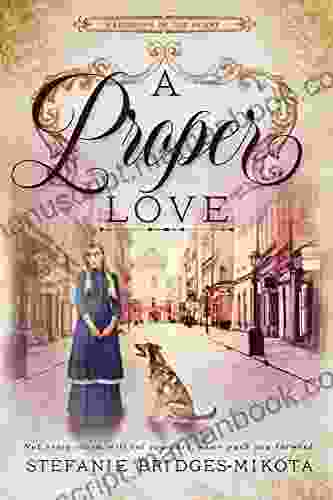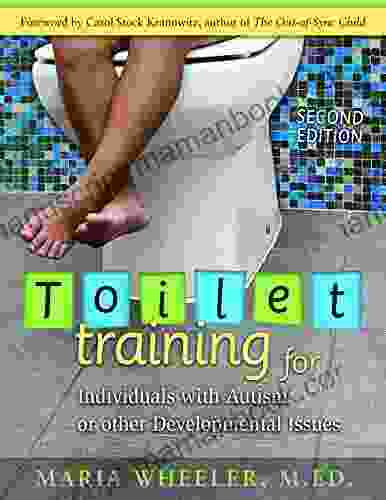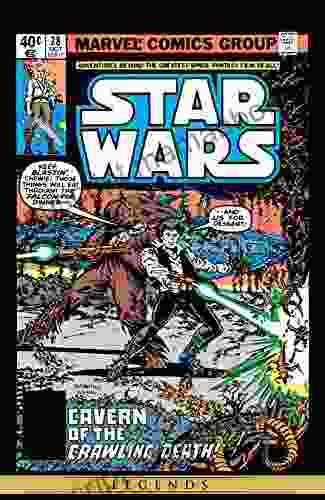A Comprehensive Guide to Toilet Training for Individuals with Autism or Other Developmental Issues

Toilet training is a crucial milestone in every child's development, yet it can present unique challenges for individuals with autism or other developmental issues. These individuals may have difficulty understanding the concept of toilet training, communicating their needs, or controlling their bowel and bladder functions. However, with patience, consistency, and effective strategies, toilet training can be achieved for individuals with autism or other developmental issues.
Understanding the Challenges
Individuals with autism or other developmental issues may face specific challenges during toilet training, including:
4.3 out of 5
| Language | : | English |
| File size | : | 3859 KB |
| Text-to-Speech | : | Enabled |
| Screen Reader | : | Supported |
| Enhanced typesetting | : | Enabled |
| Word Wise | : | Enabled |
| Print length | : | 150 pages |
- Difficulty Understanding: They may not comprehend the connection between toileting and the need to eliminate.
- Communication Challenges: They may struggle to verbalize or indicate their toileting needs.
- Sensory Sensitivities: They may be sensitive to the feel of wet or soiled clothing, making it difficult to stay on the toilet.
- Motor Skills: They may have difficulty coordinating their muscles to sit on the toilet or wipe properly.
- Physiological Issues: They may experience constipation or incontinence, making it challenging to regulate bowel and bladder functions.
Creating a Supportive Environment
Before starting toilet training, it is essential to create a supportive and comfortable environment:
- Establish a Regular Routine: Set specific times for toileting, even if the child does not go initially.
- Use Visual Aids: Create visual schedules or charts to help the child understand the toilet training process.
- Choose the Right Toilet: Consider using a potty chair or a regular toilet with an insert to make it more accessible.
- Make the Bathroom Inviting: Decorate the bathroom with bright colors, use calming scents, or play soothing music.
- Reward Success: Celebrate any small achievements, such as sitting on the toilet or going potty in the right place.
Effective Toilet Training Strategies
There are several effective toilet training strategies that can be adapted to suit the specific needs of an individual with autism or other developmental issues:
1. The Picture Exchange Communication System (PECS):
- Use picture cards to represent toileting activities, such as "go potty," "sit on toilet," or "flush."
- Encourage the child to exchange the picture card for access to the toilet.
2. Prompted Toilet Training:
- Verbally and physically assist the child through the steps of toileting, such as guiding them onto the toilet and helping them wipe.
- Gradually reduce prompting as the child gains confidence.
3. Interval Training:
- Schedule regular toileting breaks throughout the day, even if the child does not appear to need to go.
- Sit the child on the toilet for a short period and gradually increase the time spent on the toilet.
4. Social Stories:
- Create personalized stories or books that describe the steps of toilet training in a positive and easy-to-understand way.
- Read the stories to the child regularly to help them internalize the concept.
5. Potty Training Dolls:
- Use dolls or stuffed animals to demonstrate how to use the toilet.
- Encourage the child to pretend to take the doll to the bathroom and assist them through the toileting process.
Addressing Common Challenges
During toilet training, it is common to encounter challenges such as:
1. Accidents:
- Remain patient and understanding. Accidents are a part of the learning process.
- Clean up calmly and reinforce the appropriate toileting behavior.
2. Refusal to Use the Toilet:
- Determine if there are any underlying sensory or communication issues making toileting uncomfortable or difficult.
- Try different toilet training strategies or consult with a specialist.
3. Constipation:
- Ensure the child is eating a balanced diet with plenty of fiber.
- Consider using gentle laxatives or stool softeners as directed by a doctor.
4. Incontinence:
- Rule out any underlying medical conditions that may be causing incontinence.
- Use absorbent pads or underwear to protect against accidents.
- Gradually increase the time between toilet breaks to help the child develop bladder and bowel control.
Additional Tips
- Collaborate with the child's therapist or pediatrician for personalized guidance and support.
- Stay positive and focus on the child's progress, no matter how small.
- Celebrate successes and provide verbal praise and rewards.
- Be patient and avoid punishment, as it can hinder the child's progress.
- Consider using assistive technology, such as vibrating watches or moisture-sensing pads, to enhance communication.
Toilet training for individuals with autism or other developmental issues requires patience, consistency, and effective strategies. By understanding the unique challenges these individuals face, creating a supportive environment, and implementing tailored toilet training techniques, it is possible to achieve success. Remember, every child is different, and their toilet training journey will be unique. With perseverance and a commitment to support, individuals with autism or other developmental issues can gain independence and confidence in managing their toileting needs.
4.3 out of 5
| Language | : | English |
| File size | : | 3859 KB |
| Text-to-Speech | : | Enabled |
| Screen Reader | : | Supported |
| Enhanced typesetting | : | Enabled |
| Word Wise | : | Enabled |
| Print length | : | 150 pages |
Do you want to contribute by writing guest posts on this blog?
Please contact us and send us a resume of previous articles that you have written.
 Top Book
Top Book Novel
Novel Fiction
Fiction Nonfiction
Nonfiction Literature
Literature Paperback
Paperback Hardcover
Hardcover E-book
E-book Audiobook
Audiobook Bestseller
Bestseller Classic
Classic Mystery
Mystery Thriller
Thriller Romance
Romance Fantasy
Fantasy Science Fiction
Science Fiction Biography
Biography Memoir
Memoir Autobiography
Autobiography Poetry
Poetry Drama
Drama Historical Fiction
Historical Fiction Self-help
Self-help Young Adult
Young Adult Childrens Books
Childrens Books Graphic Novel
Graphic Novel Anthology
Anthology Series
Series Encyclopedia
Encyclopedia Reference
Reference Guidebook
Guidebook Textbook
Textbook Workbook
Workbook Journal
Journal Diary
Diary Manuscript
Manuscript Folio
Folio Pulp Fiction
Pulp Fiction Short Stories
Short Stories Fairy Tales
Fairy Tales Fables
Fables Mythology
Mythology Philosophy
Philosophy Religion
Religion Spirituality
Spirituality Essays
Essays Critique
Critique Commentary
Commentary Glossary
Glossary Bibliography
Bibliography Index
Index Table of Contents
Table of Contents Preface
Preface Introduction
Introduction Foreword
Foreword Afterword
Afterword Appendices
Appendices Annotations
Annotations Footnotes
Footnotes Epilogue
Epilogue Prologue
Prologue Elaine Boddy
Elaine Boddy Ed Gillentine
Ed Gillentine Amanda Blake Soule
Amanda Blake Soule Michael Punke
Michael Punke Luis Chesney Lawrence
Luis Chesney Lawrence Mark Russell
Mark Russell Rebecca Mascull
Rebecca Mascull M I Seka
M I Seka Alankruti Naik
Alankruti Naik Hiro Ainana
Hiro Ainana Tui T Sutherland
Tui T Sutherland Shmuel Breban
Shmuel Breban Tara Broeckel Ooten
Tara Broeckel Ooten Angela J Dawson
Angela J Dawson Denise Weldon Siviy
Denise Weldon Siviy N Runnels
N Runnels Marco Catalano
Marco Catalano Joyce Dipastena
Joyce Dipastena Coco M
Coco M Marcia Wilson
Marcia Wilson
Light bulbAdvertise smarter! Our strategic ad space ensures maximum exposure. Reserve your spot today!

 Graham BlairThe Sonnets Annotated By Henry Hudson With An Introduction By Charles Harold:...
Graham BlairThe Sonnets Annotated By Henry Hudson With An Introduction By Charles Harold:...
 Joseph HellerPoetry Collection: Haiku, Senryu, Other Forms, Shapes, and Free Verse Poems...
Joseph HellerPoetry Collection: Haiku, Senryu, Other Forms, Shapes, and Free Verse Poems... Sidney CoxFollow ·17.9k
Sidney CoxFollow ·17.9k Drew BellFollow ·10.3k
Drew BellFollow ·10.3k Isaiah PriceFollow ·15.3k
Isaiah PriceFollow ·15.3k Travis FosterFollow ·13k
Travis FosterFollow ·13k Eliot FosterFollow ·18.7k
Eliot FosterFollow ·18.7k Davion PowellFollow ·11.4k
Davion PowellFollow ·11.4k Brenton CoxFollow ·2.1k
Brenton CoxFollow ·2.1k Bob CooperFollow ·2.7k
Bob CooperFollow ·2.7k

 Jaylen Mitchell
Jaylen MitchellPretime Piano Jazz Blues Primer Level: A Comprehensive...
The Pretime Piano...

 Mark Twain
Mark TwainSurviving and Thriving with the Self-Absorbed: A...
Interacting with self-absorbed...

 John Keats
John KeatsTo Love Is To Surrender: A Deep Dive into the...
Surrender is one of the most enigmatic and...

 Steven Hayes
Steven HayesRich Murphy: A Visionary Engineer Shaping the Future of...
In the annals of space...

 Neil Parker
Neil ParkerProper Love: Navigating the Hardships of the Heart
Love is a beautiful emotion that can bring...
4.3 out of 5
| Language | : | English |
| File size | : | 3859 KB |
| Text-to-Speech | : | Enabled |
| Screen Reader | : | Supported |
| Enhanced typesetting | : | Enabled |
| Word Wise | : | Enabled |
| Print length | : | 150 pages |










